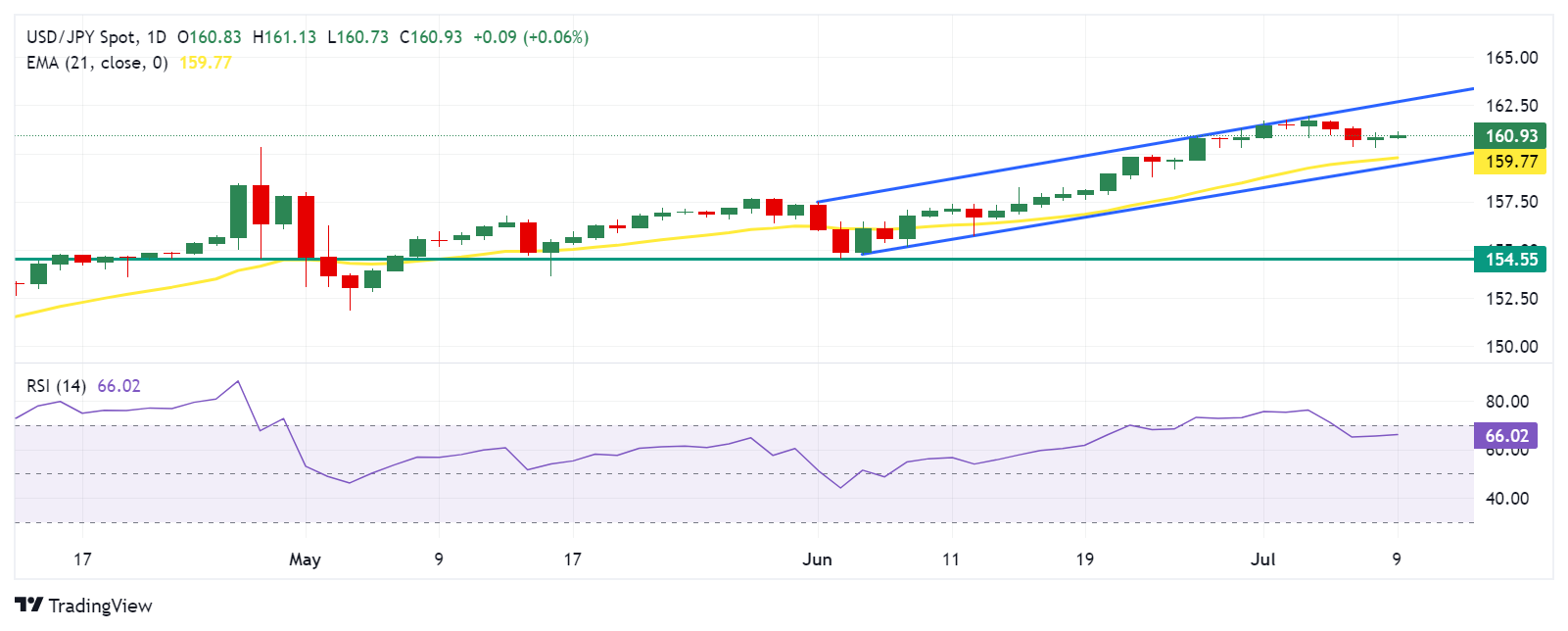- The Japanese Yen is struggling due to purchases of overseas assets by Japanese individuals through the NISA program.
- The BoJ is ready to assess a viable strategy to reduce its purchases of government bonds.
- Fed Chair Powell is expected to deliver a comprehensive review of the economy and monetary policy to Congress on Tuesday.
The Japanese Yen (JPY) extended its losses for the second consecutive session on Tuesday. The slight improvement in the US Dollar (USD) supported the USD/JPY pair. However, the JPY could limit its decline due to fears of intervention by Japanese authorities in the currency markets.
The Japanese Yen is also struggling due to purchases of overseas assets by Japanese individuals through the newly revamped tax-free investment scheme, the Nippon Individual Savings Account (NISA) program. According to Nikkei Asia, the scale of these purchases is expected to exceed the country’s trade deficit during the first half of this year.
US Treasury yields are under pressure amid growing speculation that the Federal Reserve (Fed) could cut interest rates in September, potentially limiting the upside of the US dollar. The CME’s FedWatch tool indicates that rate markets price in a 76.2% probability of a rate cut in September, up from 65.5% just a week earlier.
Federal Reserve Chairman Jerome Powell will deliver his “Semi-Annual Monetary Policy Report” to the U.S. Congress on Tuesday. Powell is expected to provide an overview of the economy and monetary policy, with his prepared remarks being released ahead of his appearance on Capitol Hill.
Daily Market Wrap: Japanese Yen falls on foreign capital outflows
- According to a Bloomberg report on Tuesday, the Bank of Japan is holding three face-to-face meetings with banks, securities firms and financial institutions in the coming days. The purpose of these meetings is to assess a feasible pace for reducing its purchases of Japanese government bonds.
- Japan’s Finance Ministry said Monday that Japanese investment fund management companies and asset management firms bought 6.16 trillion yen ($38 billion) more in overseas stocks and mutual fund shares than they sold during the first six months of the year.
- Rabobank FX analysts note that they expect USD/JPY to remain around the 160 level over the next month, with the pair retreating to 152 by year-end. “The US Dollar (USD) could remain under pressure in the coming weeks, allowing USD/JPY to remain close to 160.”
- On Monday, the Bank of Japan (BoJ) maintained its economic assessment for five of Japan’s nine regions in its latest ‘Sakura Report’. The assessment for two regions was raised, while it was lowered for two other regions in the report released on Monday. As for price trends, the BoJ noted that many regions are reporting wage increases that are spreading among small businesses.
- Japan’s current account surplus extended its growth streak into the 15th month in May. The finance ministry said Monday that the current account rose to 2,849.9 trillion yen ($17.78 billion) in May from 2,050.5 trillion yen in the previous month, beating market expectations of 2,450.0 trillion yen.
- US Nonfarm Payrolls (NFP) rose by 206,000 in June, following a rise of 218,000 in May. This figure exceeded the market expectation of 190,000.
- Minutes from the Federal Reserve’s June 11-12 policy meeting, released Wednesday, suggested Fed officials were in wait-and-see mode. “Some participants emphasized the Committee’s data-dependent approach, with monetary policy decisions being conditional on economic developments rather than on a pre-set path.”
Technical Analysis: USD/JPY rises near 161.00
USD/JPY is trading around 161.00 on Tuesday. The pair remains within an ascending channel pattern, which indicates a bullish bias based on the daily chart analysis. Moreover, the momentum indicator, the 14-day Relative Strength Index (RSI), remains above the 50 level, confirming the bullish trend.
The USD/JPY pair could test the key resistance at the upper boundary of the ascending channel near the 162.55 level. A break above this level could strengthen the bullish sentiment, potentially leading the pair towards the psychological resistance at 163.00.
On the downside, the USD/JPY pair could find immediate support around the 21-day exponential moving average (EMA) at 159.78. A break below this level could put pressure on the pair to test the lower boundary of the ascending channel around 159.40. A further drop below this channel support could lead the pair to sail in the vicinity of the June low at 154.55.
USD/JPY: Daily Chart
Japanese Yen PRICE Today
The table below shows the Japanese Yen (JPY) exchange rate against major currencies today. The Japanese Yen was the weakest currency against the Euro.
| USD | EUR | GBP | JPY | CAD | AUD | NZD | CHF | |
|---|---|---|---|---|---|---|---|---|
| USD | -0.03% | 0.02% | 0.11% | 0.01% | -0.03% | 0.07% | 0.08% | |
| EUR | 0.03% | 0.03% | 0.16% | 0.03% | 0.00% | 0.11% | 0.11% | |
| GBP | -0.02% | -0.03% | 0.10% | -0.00% | -0.01% | 0.08% | 0.07% | |
| JPY | -0.11% | -0.16% | -0.10% | -0.11% | -0.15% | -0.05% | -0.05% | |
| CAD | -0.01% | -0.03% | 0.00% | 0.11% | -0.05% | 0.08% | 0.06% | |
| AUD | 0.03% | -0.01% | 0.01% | 0.15% | 0.05% | 0.09% | 0.08% | |
| NZD | -0.07% | -0.11% | -0.08% | 0.05% | -0.08% | -0.09% | 0.00% | |
| CHF | -0.08% | -0.11% | -0.07% | 0.05% | -0.06% | -0.08% | -0.00% |
The heatmap shows percentage changes of major currencies. The base currency is selected from the left column, while the quote currency is selected from the top row. For example, if you choose the Japanese Yen from the left column and move along the horizontal line to the US Dollar, the percentage change shown in the chart will represent the JPY (base)/USD (quote).
Bank of Japan FAQs
The Bank of Japan (BoJ) is the Japanese central bank, which sets the country’s monetary policy. Its mandate is to issue banknotes and carry out monetary and foreign exchange control to ensure price stability, which means an inflation target of around 2%.
The Bank of Japan has been pursuing ultra-loose monetary policy since 2013 in order to stimulate the economy and fuel inflation amid a low-inflation environment. The bank’s policy is based on Quantitative and Qualitative Easing (QQE), or printing money to buy assets such as government or corporate bonds to provide liquidity. In 2016, the bank doubled down on its strategy and further relaxed policy by first introducing negative interest rates and then directly controlling the yield on its 10-year government bonds.
The Bank of Japan’s massive stimulus has caused the Yen to depreciate against its major currency peers. This process has been exacerbated more recently by a growing policy divergence between the Bank of Japan and other major central banks, which have opted to sharply raise interest rates to combat decades-high inflation. The Bank of Japan’s policy of keeping rates low has led to a widening spread with other currencies, dragging down the value of the Yen.
The weak yen and the surge in global energy prices have caused Japanese inflation to rise, exceeding the Bank of Japan’s 2% target. However, the Bank of Japan believes that a sustainable and stable achievement of the 2% target is not yet in sight, so a sharp change in current monetary policy seems unlikely.
Source: Fx Street
I am Joshua Winder, a senior-level journalist and editor at World Stock Market. I specialize in covering news related to the stock market and economic trends. With more than 8 years of experience in this field, I have become an expert in financial reporting.








